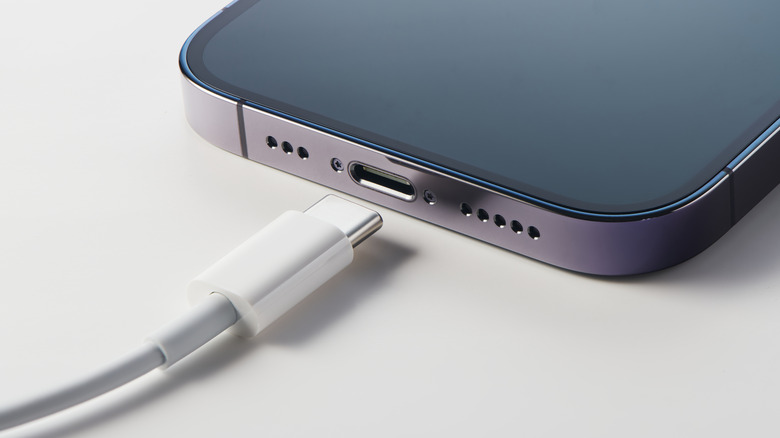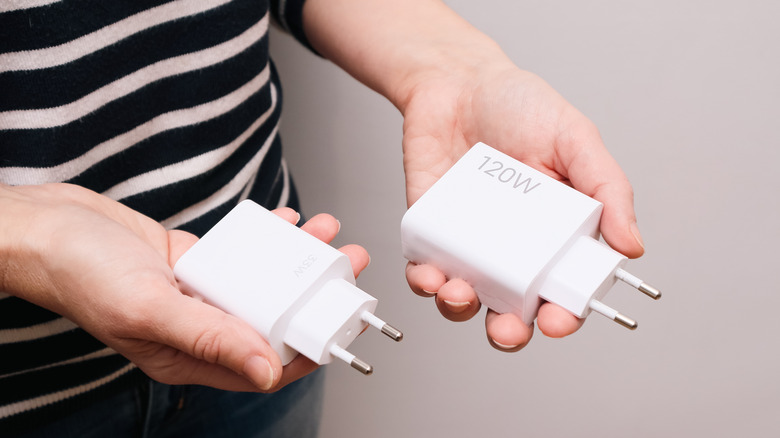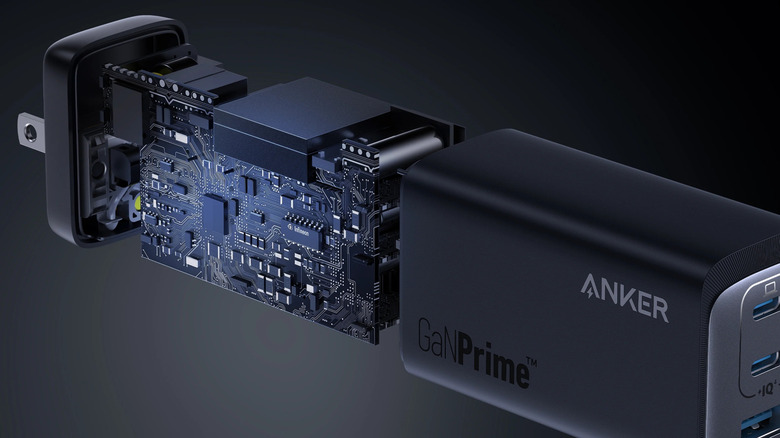Here's What You Should Look For When Buying A Phone Charger
We may receive a commission on purchases made from links.
Buying a phone charger can feel overwhelming. With so many products on the market, it's easy for your eyes to glaze over as you browse spec sheets and sort through marketing buzzwords. Things were much simpler back when major phone manufacturers like Apple and Samsung included chargers in the box; these days, you're left to fend for yourself. But getting the wrong charger can be a major headache: It might charge your phone slowly or, in the most extreme cases, even damage it. Thankfully, choosing the right charger for your phone is easy if you know what to look for.
In general, you can sort charger specifications into two buckets: those that are necessary to charge your phone optimally, and optional features that may make your life more convenient. The most important things to look for when choosing a phone charger are its charging speed, so that it charges your phone as fast as possible, as well as support for standards like USB-PD that help the device stay healthy while doing so. You can then move on to exploring other charging perks, like multiple ports to charge multiple mobile devices simultaneously, or chargers made with cutting-edge materials like gallium nitride that make them more portable and efficient. Let's dive deeper into what you should look for when buying a phone charger, and why.
Must-haves include high speed charging and USB Power Delivery
When shopping for a smartphone charger, the two primary things you should treat as non-negotiable are the charger's wattage and charging standards. Every smartphone has a top charging speed, which is the amount of power it can draw per second, expressed in watts. For instance, the Samsung Galaxy S25 Ultra charges at up to 45 watts, while the iPhone 16 Pro Max supports up to 30 watts. In order to make sure your phone charges as quickly as possible, you'll need a charger capable of delivering its maximum charging speed. In many cases, you should buy a charger with more wattage than your phone is capable of to compensate for energy inefficiency.
This goes hand-in-hand with charging standards that ensure your phone charges both quickly and safely. The most common of these is USB Power Delivery (USB-PD), which creates a digital handshake between your charger and device to optimize charging speeds, varying the voltage to prevent battery degradation or damage. Note that you don't need an expensive smartphone charger to get USB-PD, as it's a nearly universal feature these days.
Newer Google Pixel and Samsung Galaxy devices (among others) also benefit from Programmable Power Supply (PPS), a PD 3.0 feature that can prevent phone chargers from getting too hot. However, some phones use alternative standards. Qualcomm Quick Charge is often represented by a green USB port or by a symbol on the charger. Some Android manufacturers also have proprietary fast charging technologies, such as Oppo SuperVOOC, which supplies 80W or more of charging.
Nice-to-haves include multiple ports and gallium nitride technology
Once you've narrowed your selection down to chargers that meet your phone's requirements, you can focus on other features that aren't necessary but are still convenient. Nobody likes carrying multiple chargers, so a charger with enough USB ports for all your gadgets at once is a great choice. However, note that devices will divide a charger's top speed between them, and some chargers will prioritize a more power-hungry device. Before buying a multi-port charger, take a close look at the product description and spec sheet to see how it distributes power across multiple devices. The maximum power a charger can output from all its ports simultaneously is usually referred to as "total power limitation."
You may also want to consider a gallium nitride (GaN) charger. GaN is more power efficient than silicon, which allows GaN chargers to be smaller than conventional chargers while also charging faster and generating less heat. For example, this GaN Anker Nano charger can fast charge an iPhone while being small enough to fit inside a closed fist. Similarly, this UGreen Nexode 140W GaN charger has multiple ports and can charge either a MacBook Pro or multiple phones at top speed while still fitting easily into a pocket.
One last tip: Make sure you're using a cable that supports the amount of power your phone needs. Pairing a high-speed charger with a low-speed charging cable is a common mistake.


